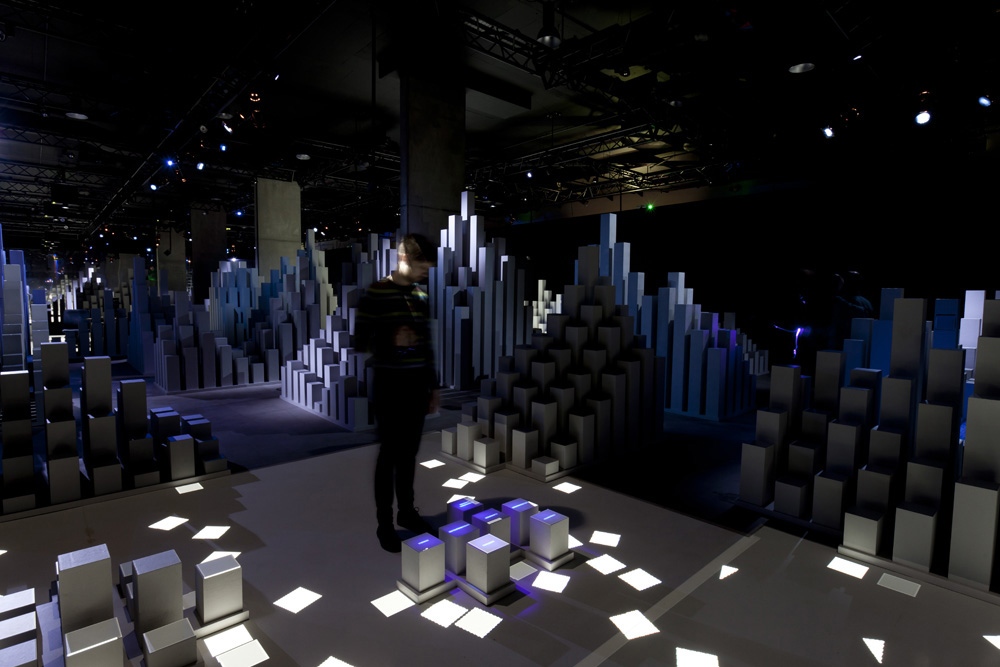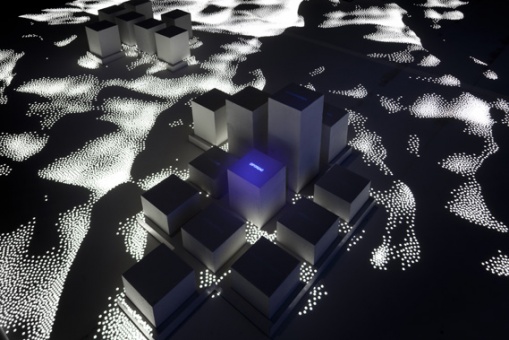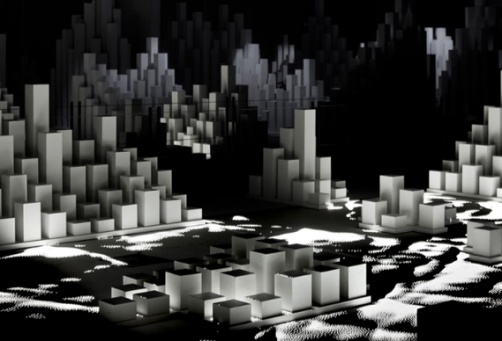Interaction is the way in which we learn through physical contact with people, objects and our environment. Physcial contact doesnt just mean touching with your hands. It can mean speaking, listening, hand gestures, touching, kicking, it can mean a number of different things. The interaction between the environment or object, and the user, depends on the concept and the way it has been designed.
This video is an interview where designers from Addison explain what Interactive design is, why it is important and how to be effective when doing interactive design work.

There are many different types and forms of user interactivity. The video on the right is very interesting interactive video on YouTube. It is nothing like the High Arctic interactive exhibition, I covered in the previous sections of this page. This is a different form of user interaction. It is an interactive story by which the user chooses how to story begins, progresses and ends.
You begin by watching a short clip, which lasts around half a minute. At the end of that clip you are given two options. The option you choose dictates what will happen to the character and the story next. There further into the story you go, the more choices you are given and the more exciting the outcomes become.
However, there is a similarity between this kind of interaction and the High Arctic. They both try and educate the user through interaction. If you watch this video and play around to find the different endings, you will find out that this is a video produced to bring awareness to knife crime and its consequences. This video using the 'Reflective Level' of user interaction because it is inviting the user to make free choices about what happens. The way in which the video has been directed also puts the user in the eyes of the main character and through this creates and evokes emotional connection between the information and the user.
As part of this module I was tasked to write a 2000 word essay on sensory engagement and the haptic. The title of the essay question I chose was 'Just Whistle', which is also the title of the project I am basing this website on (go to the 'Just Whistle' page of this site to find out more about this project). The description given in the essay title was to research and discuss an interactive designed environment or object. The interactive environment I chose is an installation at National Maritime Museum in Greenwich. The installation is called 'High Arctic' and is an environment designed interact with users through sensory engagement. What I found most interesting about the High Arctic exhibition, was that the environment didn't involve just one type of interaction from the user, if required the user to interact through a number of ways.
Below is a step by step guide of my experience whilst walking through the exhibition.
1. Before entering the exhibition I was asked to remove my bag. Once the bag had been removed, I was then was handed an ultra violet torch.
2. Once I had been handed the UV torch, I was then given instructions on how to use the torch safely and how to progress through the exhibition.
3. I then made my way into the exhibition. As I went through the entrance, my surroundings became darker and darker.
4. The first part of the exhibition I encountered, where groups of white rectangular blocks.
5. Without any idea about where to shine my torch, I became experimental and started pointing it at the groups of blocks scattered around the environment.
6. After pointing from a few different angles, I noticed the UV light revealed hidden words on the surface of each block.
7. The words made no sense to me, and I was unsure whether they where actually English as I didn't understand what they meant.
8. Curious about the words and their meaning, I began to explore the other blocks to see if I could make sense of the words. I discovered that every block in the room had a completely different word hidden on its surface.
9. After a while of exploring and experimenting with the UV light and the blocks, I soon lost interest because I couldn't understand their relevance and what they meant.
10. My attention was then brought to an area of the exhibition that was lit up in the dark space. It was a projection on the floor.
11. Curious about the projection, I pointed the UV torch at the floor to see if anything would happen. Again, I didn't see much change. It looked like waves in the sea before I pointed the torch at it and looked like waves whilst I was pointing the UV light at it.
12. I moved further into the exhibition to explore and see what else I could interact with, which is when I came across the second projection on the floor in the exhibition.
13. This projection was different to the previous one. It was a lot busier and had a lot more going on.
14. I instantly pointed the UV torch at the floor, curious to see what would happen.
15. The UV light acted like a magnet, pulled and dragging the projections toward the light.
16. This seemed fun and made me want to interact more, which is what I did.
17. After playing with the dragging and pulling of the projections, I soon realised that if I hold the UV light on them for a few seconds, they begin to break up into smaller pieces and drift away.
18. This renewed my attention and I chose a seat and started playing around some more.
19. Sitting down and interacting with the projections gave my body the chance to focus on other things in my surroundings. This made me realise and take in the sound being played in the background.
20. I had noticed the sound, but hadn't listened properly or taken it in. Through listening to the sounds, I came to realise that they are actually poems about the Arctic.
21. I decided to sit there for a while a listen to the poems a number of times, so that I could actually take in what was being said.
22. I then came to understand that the poems are being recited by different people and that the poems each have a different meaning and outlook on the global warming problems in the Arctic.
Interaction Design - from the pros
An Interactive Learning Environment

After reading through the stages above, I am sure you can see that the exhibition is flawed in some areas. The reason why it is flawed is because although the installation is engaging the user in a number of ways, through various forms of interaction, it is unclear to the user how to consume and digest the information they are being given. For instance, take the various words hidden on each block around the environment. Anyone with the smallest amount of curiosity would have eventually discovered the words, but would they know what they mean and how they relate to the exhibition? maybe, maybe not. This is why interaction, especially interactive learning environments should have simple and clear ways to users to take in the information they are interacting with.
Interaction through gesture was the main focus of the exhibit, in terms of learning from the environment. However, what I found most interactive but required no physical interaction, where the poems. The reason I found the poems to be the most interesting and engaging part of the High Arctic, is due to the emotional aspect it creates between the user and the information that the environment is conveying. The High Arctic is an interactive learning environment, its purpose is to educate people through interaction, about the effects global warming is having on the Arctic and what this effect will mean for the Arctic in the near future. The best way to educate users is to form a relationship between the information being communicated and the user.
Going back to what I mentioned previously about the words hidden on the blocks, I later discovered through asking a member of staff, that the words where actually names of individual glaciers found in the arctic. When I discovered this information, I was amazed about two things and had one question dwelling on my mind. Firstly, the question was 'are there really that few glaciers left in the Arctic, that they all have their own names'. The two things that amazed me were, people had taken time to name individual glaciers in the Arctic and the second thing was, how could the exhibit not make this more clear. I felt that the names on the glaciers, where one of the most important parts of the exhibit because naming something, whether it be a pet, a plant, a house or even a toy, creates a personal and emotional relationship between that and the person.



In the above quote Donald Norman evidently clarifies why the reflective level is the most important out of the three levels. Building a relationship between the user and the information is a key part of an interactive environment because it is how the user can relate to the information and store what they have learned. Through creating an emotional response the user may feel inclined to research more into what they have learned. A personal connection between the user and the environment may even cause the user to personally contribute to solving the problem.
It is called the Reflective level because it is the level of interaction where the use interacts with the information through reflective thought, whether that be through memories, personal experience, personal opinion etc.
“To help people make the most of a new experience, educators need to understand how prior knowledge affects learning.”
(Roschelle, Learning in Interactive Environments: Prior Knowledge and New Experience, 1995)
The above quote backs up what I mentioned before, that without knowing what the information means or how it relates to the environment, the user will disregard the information as irrelivant and may miss an important message that, that specific interaction was communicating.
Donald Norman
Donald Norman is a familiar face and name in the world of Interaction design, he has been, on many occasions, referred to as a guru of human-computer interaction.
Throughout my research for the essay and this project, I used Donald Norman, his essays and his research to gain a greater understanding of interaction design. I read many of his essays about why interaction works, why it doesn't work, what rules are there and why are they important to follow and many more. I will provide a link to the web page, where I found his essays, at the bottom of this section.
Whilst reading through and evaluating Donald Normans essays and research, there was a part of one of them which I found the most interesting. It was out of an article in the Metropolis Magazine, where he mentioned his book 'Emotional Design' (which I also read, after reading about it in this article). Below is the quote from the article which caught my eye, fueled my interest and encouraged me to find out more.

“In my book Emotional Design, I argue that the interplay between cognition and emotion occurs on three levels: the visceral, the behavioral, and the reflective.”
(Norman, Selective Memories, 2009)
This interested me because it meant that there where three levels of interaction that dictate how humans interact with an environment and successfully understand the information that is being communicated.
I found this fascinating and wanted to learn about the three levels. I knew that it was important to learn and understand the three levels that Donald Norman talks of and put them into practice. Below you can find the three levels, my understanding of them and why they are a very important part of interaction design.
Visceral Level
The level known as 'Visceral', is the lowest level of interaction design. It is a very fast, unconscious judgment based on a biological form of interaction. By this I mean that the user has no control over the interaction that they have, the brain is interacting automatically through instinct. Donald Norman gives an example of this, his example is an Interaction produced through a fear of heights.
Behavioral Level
The Behaviorial level is where the expert skills in humans come in to play. They are parts of the users body and brain, that are so frequently used and so well learned, that the user has little or no conscious effort interacting through these actions. As an example, the Behavioral level could involve interaction through the use of language, because language is something that is programmed into us as children, it becomes an effortless part of everyday life by late childhood or our early teenage years.
Reflective Level
The Reflective level is known and acknowledged as the most important level out of the three. Below is a quote by Donald Norman explaining why the Reflective level is the most important aspect to consider when designing for use interactivity.
“The reflective level ultimately dominates our perception. Why? Life is a series of temporary, fleeting experiences. The rest is, literally, memory.” (Norman, Selective Memories, 2009)


This example on the right, is the perfect way to show that interaction doesnt need to be based on computer-human interaction, it can be as simple, but still as successful, as putting post it notes on a window in the neighbourhood. Whats interesting about this is invites the neighbourhood to interact with the installation by writing down (anonymously) how much their house cost's to rent or mortgage etc. This shows how such a simple form of interaction can still be as effective as using state of the art computers and software.
This work was created by Candy Chang, from New York. By click on the photograph, you will be redirected to her site.
I stumbled across this amazing work, because I was struggling with flash and wanted to know if interactive design was all about computer-human interaction in today's technological age, or if there where any physical installment for people to interact with through touch.